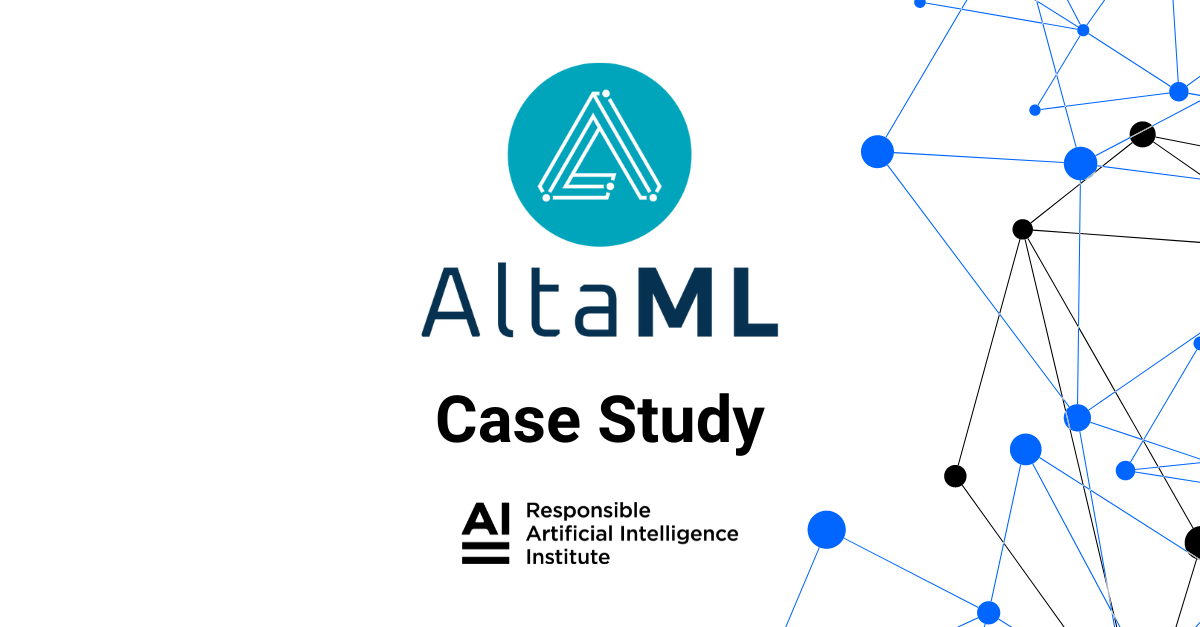Sophie the Robot, stories written by Open AI’s ChatGPT, military AI “dogs”—our culture is surrounded by fascinating yet terrifying images of robots and AI. Much of our world is supported by AI, which typically takes the form of customer service chatbots and Netflix recommendations rather than walking, talking robots ready to take over the world. it’s still vital that we prioritize making it possible to trust our AI because it has as much capability to harm as it has to change the world.
We have seen the horror stories of automated decision-making systems sending people to prison or failing to recommend medical treatment to Black patients. We also have seen examples of the wondrous side of AI, where AI can draw insights from data faster than humans ever could to detect and treat disease or provide critical accessibility tools for disabled individuals.
So how can we ensure that this AI is trustworthy, ethical, and responsible? What does that look like?
What is Artificial Intelligence (AI)?

Merriam Webster’s definition of AI.
First, let’s establish some key terms. Across legislation, research, and literature, there are many definitions and interpretations of what “AI” is, and how to define AI is an ongoing discussion in the field. At the RAI Institute, we tend to reference the Organisation for Economic Co-operation and Development (OECD)’s definition of artificial intelligence:
“The OECD defines an Artificial Intelligence (AI) System as a machine-based system that can, for a given set of human-defined objectives, make predictions, recommendations, or decisions influencing real or virtual environments.”
The OECD categorizes AI use cases into the following seven patterns:

OECD’s Seven Patterns of AI.
Technologies like machine learning (ML), natural language processing (NLP), and deep learning are integral to AI.
Machine learning refers to processes in which machines are “taught” how to carry out a function based on structured big datasets and both algorithmic and human feedback. Deep learning refers to a more advanced type of ML that learns through representation and can handle unstructured data. Finally, natural language processing is a linguistic computer science tool that allows machines to interpret human language.
Examples of AI
Given its expansive applications and potential, you can imagine how a wide range of today’s technology falls under the umbrella of AI. Here are a few examples of everyday AI use cases across the globe:
- Digital maps and navigation apps
- Body scanners at airports
- Autocorrect and suggestive text on our phones
- Manufacturing robots
- Self-driving cars
- Digital assistants on your device
- Healthcare management.
- Automated financial investing
- Personalized streaming or ad recommendations
- Virtual travel booking agent
- Electronic payments
- Social media monitoring
- Marketing chatbots
What is Responsible AI?
But what does it mean for that AI to be “responsible”? Responsible AI represents a combination of characteristics; it’s trustworthy, designed with power dynamics and ethics in mind, with minimized risk.
Why “Responsible AI”?
So what’s the difference between Responsible, Ethical, and Trustworthy AI?
These terms often get used interchangeably, and people who use them are often interested in the same goals and objectives. However, it’s essential to understand these distinctions as they could be used to either mean different things or focus on other aspects of AI’s use in society.
At the RAI Institute, we like to use the comprehensive term “responsible,” as it refers to values-driven responsible actions taken to mitigate harm to people and the planet. In contrast, ethics are values specific to an individual or group and can vary and conflict. While considering one’s values is incredibly important, it is essential to target objectives that benefit people and the planet as an integrated ecosystem.
While many in the community choose to use ethics as a term, we recognize that not everyone has the same ethics. It is not our place to define what is or isn’t ethical for an individual. When you are being responsible, it means you recognize the impact of your actions and are taking steps to ensure an individual or group’s choices, liberties, and preferences are not harmed. What is essential as part of responsible AI operations is that organizations define their own AI ethics principles and make these transparent to their employees and customers.

The term “Trustworthy AI” is most often used to reference the technical implementation of AI. It’s focused mainly on ensuring fairness through the detection and mitigation of bias and ensuring AI models are transparent and explainable.
Responsible AI, Ethical AI, or Trustworthy AI all relate to the framework and principles behind the design, development, and implementation of AI systems in a manner that benefits individuals, society, and businesses while reinforcing human centricity and societal value.
Responsible remains the most inclusive term ensuring that the system is not just safe or trusted but that it also respects and upholds human rights and societal values as well.
Responsible AI in Practice
Determining what RAI means and what it looks like in practice is key to our work. Over the past five years, the RAI Institute team has aggregated extensive information from various perspectives, including those researching, designing, building, deploying, using, and overseeing AI, to understand what responsible AI looks like today.
Building on these learnings and leading frameworks, such as the Organisation for Economic Co-operation and Development (OECD), United Nations Educational, Scientific and Cultural Organization (UNESCO), Institute of Electrical and Electronics Engineers (IEEE), and many more, our Framework of Responsible AI is composed of six dimensions:
- Data and Systems Operations
- Explainability and Interpretability
- Accountability
- Consumer Protection
- Bias and Fairness
- Robustness

These dimensions are key to ensuring that an AI system is designed, developed, and deployed responsibly. Check out more information about our framework in our whitepaper here.
Why Responsible AI Matters

Forecasted AI market growth from Raison Management.
Modern AI technologies have great potential to advance our society but with that power comes great responsibility to use that power for good and in an equitable, transparent manner. AI has a significant impact, and ensuring that AI is designed, deployed, and used responsibly is critical to ensuring this impact is positive.
AI is Everywhere
We should care about responsible AI because it impacts many of our daily lives. AI is involved when you log onto social media, request a loan from the bank, check into the doctor’s office, and travel in airports.
AI is Growing
This problem is urgent and significant, particularly because AI adoption is widespread. As of 2022, the global AI market is valued at over $387.4 billion and is projected to more than triple by 2029.
AI Can Magnify Harm
Because AI applications already surround us and AI can be applied easily on a broad scale, it has the potential to amplify the biases of its creator
Incidents of AI gone wrong, being used irresponsibly, or being just plain scary are all around us. The consequences can be dire—affecting millions of people, misusing their data, invading their privacy, misdiagnosing their health conditions, and even resulting in imprisonment or death.

To keep track of the prevalence of these negative consequences, the AI Incident Database is dedicated to indexing the collective history of harms or near harms realized in the real world by deploying artificial intelligence systems. Like similar databases in aviation and computer security, the AI Incident Database aims to learn from experience so we can prevent or mitigate bad outcomes.
Additionally, organizations like the Algorithmic Justice League invite the public to share the story of their experiences with AI. Gathering and disseminating this data is critical to spreading awareness of AI’s impacts and cataloging trends.
We Can Shape AI for Good
To minimize the harm done by AI, a responsible lens is critical in guiding how AI touches our society and ensuring people retain their dignity and human rights.
And the beauty of this moment in our history is that negative impacts are not inevitable. We have an opportunity to shape the future of this field and AI/human interactions for years to come. By studying industry best practices and ethics and AI literature, we can better understand AI, determine when they’re best used, and build them in ways that reduce harm.
Thankfully, demand for responsible AI is strong and will only grow as global regulatory efforts to promote RAI adoption are gathering steam.
AI vs. Responsible AI
Responsible AI operates under a framework of responsibility, trustworthiness, and ethics—embodying our six dimensions above, effective Data and System Operations, Explainability and Interpretability, Accountability, Consumer Protection, Bias and Fairness, and Robustness. We believe that AI design requires RAI design frameworks embedded at every stage.
In practice, an AI system might be designed to process consumer data to personalize ads, while the responsible design of that same AI system would have safeguards in place. This could look like providing a notification to end-users about how and when their data is used, giving them opportunities to understand why the AI system is used, and providing avenues for redress in cases where the system goes wrong.
Let’s take a hiring use case as an example. Recent research finds that 65% of recruiters today use AI in their candidate search. Companies might rely on models to recommend where to place their job listing on job boards like Linkedin, or they might even require job applicants to record a video interview screened by an AI system to sort qualified candidates from unqualified ones.
Risks associated with AI use cases must be evaluated and properly addressed. An organization that values and embeds responsible AI principles into its AI governance, policies, and practices would take steps to understand and mitigate, these risks.
These steps could include engaging a panel of stakeholders to solicit input on the risks of the system and creating a responsible AI governance board within the organization to oversee anti-bias testing and checks. Furthermore, in some cases, the most responsible choice could be not to use AI or as originally intended and to find another way to accomplish the company’s objectives.

Final Thoughts
Many valid fears circulate about responsible AI. As a result, the work of our time lies in addressing those fears by building AI systems that reduce harm and building policy that ensures that generations down the line can be responsible and ethical.
Currently, while consumer and data protection laws affect the use of AI systems, companies are primarily self-regulating their responsible AI use. But “self-grading” their AI use means that companies likely aren’t checking all the necessary boxes to mitigate risk.
That’s where independent assessments and audits come in, to objectively evaluate a company’s AI system, policies, practices, and team members and demonstrate the gap between their status quo and full conformity with regulation and best practices.
Our mission and why we exist is to increase the adoption of Responsible AI practices by offering precisely those independent assessments. The Responsible AI Institute (RAI Institute) is an independent non-profit organization dedicated to advancing the adoption of safe and trusted AI systems through the development of assessments and the first accredited certification program for AI systems.
The Responsible AI Institute (RAI Institute) is developing one of the world’s first responsible AI accredited certification programs. Based on a harmonized review with the American National Standards Institute (ANSI) and United Kingdom Accreditation Service (UKAS), the RAI Institute Certification Program aligns with emerging global AI laws and regulations, internationally agreed-upon AI principles, research, emerging best practices, and human rights frameworks.
We’re excited to currently be undergoing a partnership with the Standards Council of Canada (SCC) in a first-of-its-kind pilot to determine requirements for the development of a conformity assessment program for AI management systems.
Learn more about the RAI Institute’s work to launch our AI system certification.





